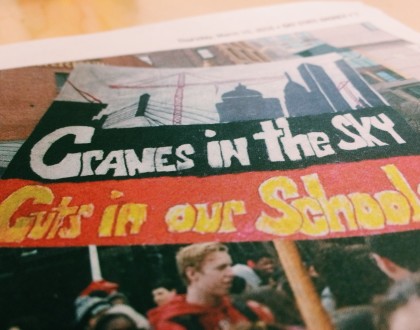“Cranes in the Sky | Cuts in our Schools”

I was always impressed by the Central branch of the Boston Public Library. The imposing lion sculptures, the impressive study halls and the old and new shelves of books all gave the space a sense of wealth and grandeur. I even attempted one Saturday morning to spend the day studying there, hoping that the feeling of awe I had toward the place would cast away any desire for procrastination. And, it worked – for a few minutes. What is even more interesting is that another Saturday morning, I decided to visit a different branch of the Boston Public Library, the Dudley branch. One of the front doors of the building, however, was not functional, the tables and chairs looked old, the pots of plants were dusty and the shelves, those platters of wealth, were small in number and some, absolutely empty.
As I processed the fact that the Central branch was undergoing massive renovations while the Dudley branch seemed to be left under-resourced, one question lingered: why is it that resources are taken away here yet provided for there?
The same question may apply to the recent rally students of the Boston Public Schools organized to protest against the possible budget cuts that would impact them in the near future. Because of budget cuts,
- Boston Latin School will continue to function without grade 8 science classes, as it has been for the past 36 years.
- Jeremiah E. Burke High School will have its students graduate without certain college requirements.
- Many schools will not be able to afford librarians, which will then jeopardize those schools accreditation among other things.
These are just a few examples yet it does not stop there. One of the latest articles of the Boston Globe discusses the large income gap in the city, where about half of its residents have an income of less than $35,000 a year compared to $266,000 a year of Boston’s top 5%. One of the things they mention is the fact that entry level positions are now requiring higher education degrees while positions without such requirements are essentially unattractive and low-paying jobs. Now, if we think about the Boston Public School students, their protest comes from the fear of being engulfed by a cycle of poor high school education leading to lower rates of college attendance and graduation, leading to low-paying jobs, leading to poverty in the city for them and for their future families.
At the #bpswalkout rally, one of the signs photographed and published in the Banner said the following: “Cranes in the City | Cuts in the Schools”. This sign referenced the sharp contrast between a wealth of resources via new development for example and the lack of resources they have been and continue to suffer from. Again, the same question lingered: why is it that resources are taken away here yet provided for there? What are we really investing our time and effort in, not only as a city but as individuals?
This question can be answered in many ways. In fact, some find that rallying is the best way to answer it. Others find that working for non-profits is the best way to do so. Others find that volunteering, donating, starting or leading influential companies or acquiring knowledge about issues is the best way they know to answer the question. Whatever your answer is, what is most important is perhaps that you think about the question and that you find your own way of answering it because, as cliché as it may sound, the future of our children does depend on it.
(Photo: Picture of 3/10/16 issue of the Bay State Banner)
